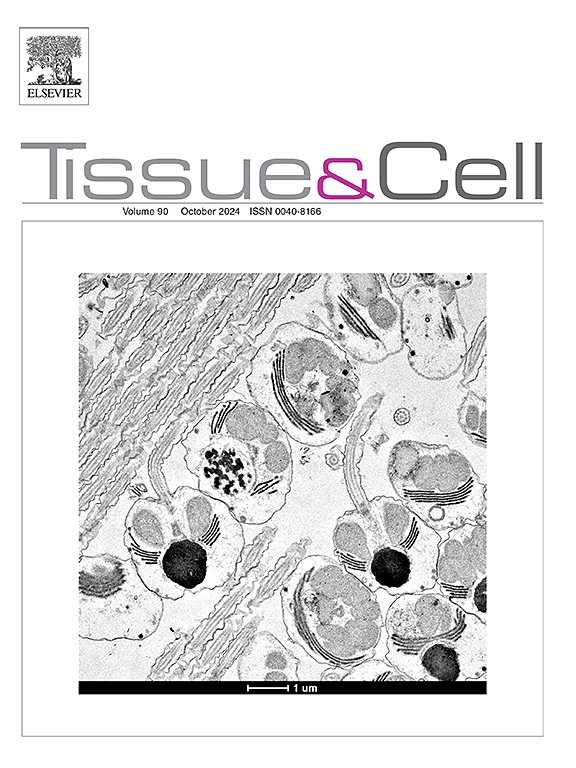TACC3通过减弱软骨发育不全中异常激活的FGFR3信号通路,促进软骨细胞分化
IF 2.7
4区 生物学
Q1 ANATOMY & MORPHOLOGY
引用次数: 0
摘要
软骨发育不全是侏儒症的一种常见形式。它是由成纤维细胞生长因子受体3 (FGFR3)突变引起的,该突变抑制软骨细胞增殖和分化。在这项研究中,我们打算研究FGFR3突变诱导的软骨细胞分化缺陷的潜在机制。方法采用胰岛素-转铁蛋白-硒(ITS-G)刺激ATDC5细胞作为体外模型。阿利新蓝染色检测ATDC5细胞分化情况。结果ATDC5细胞分化过程中stacc3表达增加。ITS-G诱导的ATDC5细胞分化受到FGFR3突变的抑制,ACAN和COL2A1的表达下降就是证据。ITS-G刺激诱导的TACC3表达下调通过FGFR3过激活而上调。TACC3抑制剂(KHS101)促进FGFR3突变ATDC5细胞的分化。p38信号通路与FGFR3突变诱导的软骨细胞分化缺陷有关。KHS101促进p38的表达。khs101诱导的ATDC5细胞分化的增加被p38抑制剂抑制。这些结果表明,TACC3可能通过p38信号通路在FGFR3突变引起的软骨细胞分化缺陷中发挥作用。结论tacc3可能是软骨发育不全的新靶点。本文章由计算机程序翻译,如有差异,请以英文原文为准。
TACC3 facilitates chondrocyte differentiation by attenuating abnormally activated FGFR3 signaling in achondroplasia − An in vitro study
Background
Achondroplasia is a common form of dwarfism. It is caused by mutations in the fibroblast growth factor receptor 3 (FGFR3), which inhibits chondrocyte proliferation and differentiation.
Aim
In this study, we intended to investigate the underlying mechanism of FGFR3 mutation-induced chondrocyte differentiation defection.
Method
Insulin-transferrin-selenium (ITS-G) stimulated ATDC5 cells was used as an in vitro model. Alcian Blue staining was performed to detect ATDC5 cell differentiation.
Results
TACC3 expression was increased during ATDC5 cell differentiation. ITS-G induced ATDC5 cell differentiation was inhibited by the FGFR3 mutation, as evidenced by the decreased expression of ACAN and COL2A1. The downregulation of TACC3 expression induced by ITS-G stimulation was upregulated by FGFR3 overactivation. The TACC3 inhibitor (KHS101) promoted differentiation in FGFR3 mutant ATDC5 cells. The p38 signaling pathway has been implicated in FGFR3 mutation-induced chondrocyte differentiation defects. KHS101 promoted the expression of p38. KHS101-induced increase in ATDC5 cell differentiation was inhibited by the administration of a p38 inhibitor. These results suggest that TACC3 might play a role through the p38 signaling pathway in chondrocyte differentiation defects caused by FGFR3 mutations.
Conclusion
TACC3 might represent a novel target for achondroplasia.
求助全文
通过发布文献求助,成功后即可免费获取论文全文。
去求助
来源期刊

Tissue & cell
医学-解剖学与形态学
CiteScore
3.90
自引率
0.00%
发文量
234
期刊介绍:
Tissue and Cell is devoted to original research on the organization of cells, subcellular and extracellular components at all levels, including the grouping and interrelations of cells in tissues and organs. The journal encourages submission of ultrastructural studies that provide novel insights into structure, function and physiology of cells and tissues, in health and disease. Bioengineering and stem cells studies focused on the description of morphological and/or histological data are also welcomed.
Studies investigating the effect of compounds and/or substances on structure of cells and tissues are generally outside the scope of this journal. For consideration, studies should contain a clear rationale on the use of (a) given substance(s), have a compelling morphological and structural focus and present novel incremental findings from previous literature.
 求助内容:
求助内容: 应助结果提醒方式:
应助结果提醒方式:


